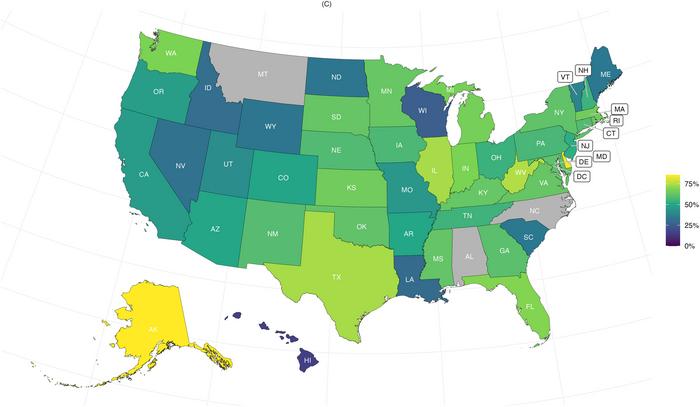image:
Unadjusted CACFP Participation Rates among Licensed Child Care Centers Across States, Low-Income Areas Only (n=17,229)
view more
Credit: American Journal of Preventive Medicine
Ann Arbor, November 6, 2023 – Current participation rates in the US federal Child and Adult Care Food Program (CACFP) by licensed child care centers point to program underutilization and unequal access, according to the first nationwide analysis of data on CACFP participation in the American Journal of Preventive Medicine, published by Elsevier.
Lead investigator Tatiana Andreyeva, PhD, Department of Agricultural and Resource Economics, Rudd Center for Food Policy and Health, University of Connecticut, explained, “Unfortunately, CACFP is underutilized and underappreciated. Despite offering robust program benefits, including better nutrition for children, help for families, food cost reimbursement for child care providers, and the local infusion of federal dollars, our study found that participation – averaging only 36.5% across all licensed centers and 57.5% in low-income areas – lags behind other federal nutrition assistance programs and is unequal across states.”
Participation rates across states varied from 15.2% to 65.3% in the full study sample, and from 15.7% to 85.7% in low-income areas. Higher-income areas had an average participation rate of 31.8%. Similarly, there were differences in CACFP participation rates across USDA regions, with the highest rates observed in the Southeast and lowest in the West and Mountain Plains regions.
CACFP is one of the 15 federal nutrition assistance programs intended to reduce food insecurity and improve nutrition. It provides reimbursements for meals and snacks served to participating child care centers, family daycare homes, emergency shelters, after-school programs, and adult daycare centers, reaching 4.58 million individuals in fiscal year (FY) 2022. The investigators point out that CACFP reaches children at the most critical age, from 0-5 years, for sowing maximal economic and social returns.
Data were collected from the state agencies that oversee licensing and CACFP and merged with data that included sociodemographics to assess household income in communities where centers were located. CACFP-eligible child care centers were identified based on their location in low-income areas. Three states did not provide adequate data and were excluded (Alabama, Montana, and North Carolina).
The study identified contributing factors for CACFP’s inconsistent uptake. While some states are successful in getting providers to join the program, the investigators found surprisingly large variation.
Dr. Andreyeva said, “States have power to increase access to the program that would help so many young children and their care providers. Understanding factors shaping the decisions of child care centers to provide meals and participate in CACFP should be a priority for the USDA, state agencies, and advocates seeking to improve child nutrition and food security.”
The recommendations include encouraging states to regularly assess/track participation among eligible providers and emphasize program outreach. In addition, federal policymakers can and should play a much larger role in expanding access to CACFP. At the federal level, CACFP does not appear to receive the attention and funding that other nutrition assistance programs do.
Co-investigator Erica L. Kenney, ScD, Department of Nutrition, Harvard T.H. Chan School of Public Health, elaborated, “CACFP has potential to help feed so many young kids, but we see evidence that the program is not being used consistently. We want to acknowledge the states that do a phenomenal job in getting providers to join the program and feed kids.”
Journal
American Journal of Preventive Medicine
Method of Research
Data/statistical analysis
Subject of Research
People
Article Title
Federal Nutrition Assistance for Young Children: Underutilized and Unequally Accessed
Article Publication Date
12-Sep-2023
Disclaimer: AAAS and EurekAlert! are not responsible for the accuracy of news releases posted to EurekAlert! by contributing institutions or for the use of any information through the EurekAlert system.
